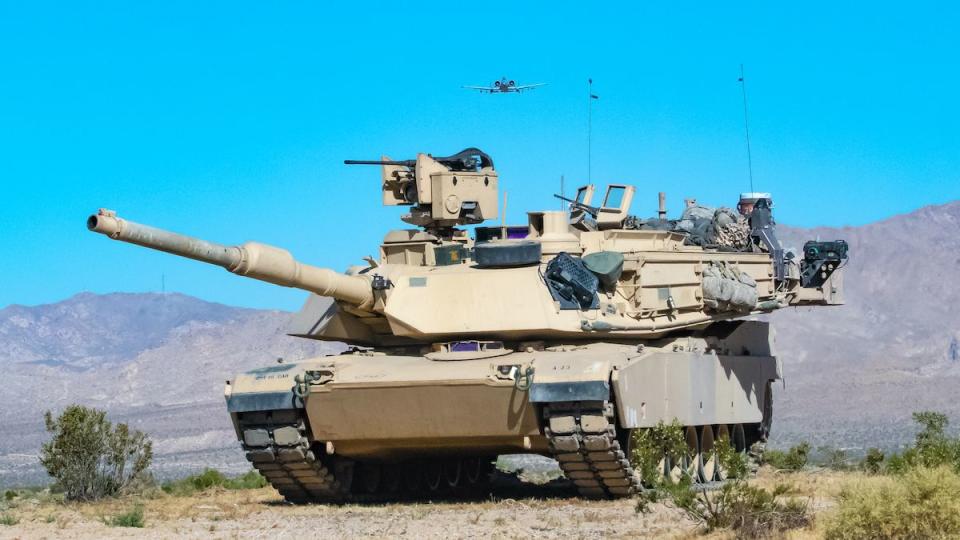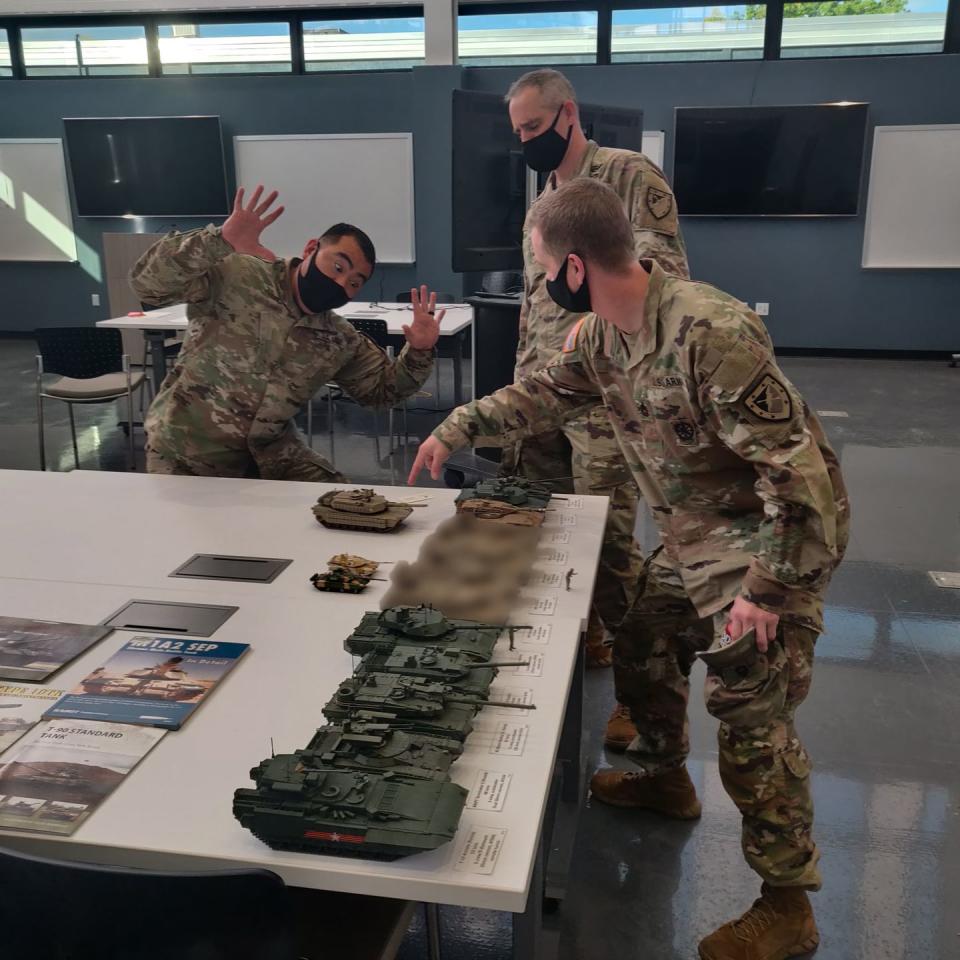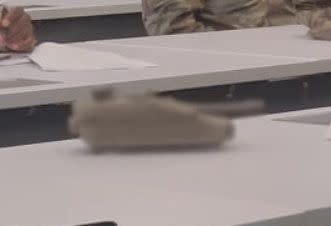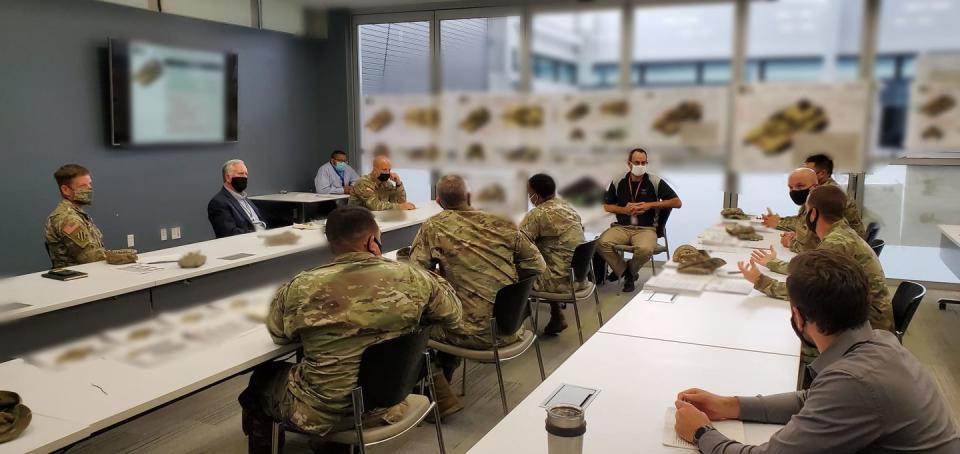What Will the Army's M1 Abrams Tank Replacement Look Like?
Photos taken at a U.S. Army workshop hold clues to what a replacement for the U.S. Army’s Abrams tank might look like.
Concept photos are blurred, but we can get an idea of the rough shape of the vehicles.
The new Optionally Manned Tank will be able to operate crewed or uncrewed on the future battlefield.
Several images taken at a U.S. Army workshop show a very rough idea of a possible replacement for the long-serving M1 Abrams tank. The images seem to depict at least three concept tanks, including one behemoth that dwarfs the 70-ton Abrams. The Army plans to make a decision about if and how to replace the Abrams in 2023.
➡ You love badass military tech. So do we. Let's nerd out over it together.
The event, a three-day workshop, was held in early October at the U.S. Army’s Ground Vehicle Systems Center at Detroit Arsenal. According to the Army, the event paired soldiers “with a team of industrial designers and Subject Matter Experts” to explore topics “from crew size to unmanned and autonomous considerations.” The team also “explored levels of desired lethality, mobility, and survivability applied to a number of concept platforms.”

The Army currently operates the M1A2 Abrams main battle tank. The service developed the Abrams in the late 1970s and began using it in the early 1980s. Although the basic design is more than 40 years old, several upgrades, including a larger main gun, depleted uranium armor, improved thermal imaging sensors, improved crew protection, and battlefield networking systems have allowed the M1 series to keep pace with armor threats.
The latest upgrade, Israel’s Trophy active protection system, uses a combination of turret-mounted radars and projectile interceptors to shoot down incoming anti-tank missiles before they hit the tank.
The Army has tried several times to replace the Abrams; at one point in the 2000s, the service spent billions without building a single vehicle. The October workshop was part of yet another effort, known as Optionally Manned Tank (OMT), to design a new main battle tank. OMT is pretty self-explanatory, but the Army is weighing exactly what it wants in a future tank—especially one that will probably serve as long as the current M1 Abrams.

One image from the workshop shows a number of scale models of contemporary tanks and fighting vehicles. The vehicles are 1/35 scale and built from commercial model kits and represent many of the most modern main battle tanks worldwide. At least three vehicles, presumably concept vehicles for the OMT, are present.

One of the OMT concept vehicles appears to feature a large, slab-like turret considerably larger than the M1 Abrams’s turret.
We don’t know exactly what most of the OMT concept models look like, but we can make some guesses. Assuming there are three models, they will almost certainly represent small, medium, and heavy versions of the OMT.
A smaller vehicle could retain a large gun, but carry less ammunition. It would also be lighter, allowing it to be carried by aircraft such as the C-17 Globemaster III, and substitute traditional heavy tank armor for an active protection system.
A medium-sized vehicle would be in the weight class of the M1A2 Abrams, while a large vehicle would be even bigger, retaining heavy armor to shrug off enemy anti-tank gun rounds and missiles but at the expense of strategic mobility. The medium and large tanks would be about the same width, in order to fit on railroad cars.
Here's a purported image of one of the OMT designs, posted several months ago to Twitter. The image on the right appears pulled from this PowerPoint presentation.
Image of NGCV OMT (Next Generation Combat Vehicle Optionally Manned Tank) project.#USArmy #Tank #MBT #NGCV #OMT
Via @PJ_shoui pic.twitter.com/Mqod6Fw4le— The Dead District (@TheDeadDistrict) August 3, 2020
Each tank concept vehicle entails risk. A lighter vehicle could be deployed faster by air, but would rely heavily on the active protection system, which could be less effective against high-velocity, anti-tank rounds. A medium-sized vehicle would have to squeeze new systems, such as active protection, the ability to launch and recover drones, and perhaps even anti-drone lasers, into the tank while still supporting future growth.
A heavy tank would offer the best protection and future-proofing at the expense of strategic and tactical mobility, fitting fewer tanks in transport aircraft and leaving the tank unable to cross lighter civilian bridges.
The OMT tank will likely be equipped with a larger, more powerful gun than the M256 120-millimeter gun fitted to the M1A2 Abrams. One possibility is the new Rheinmetall 130-millimeter tank gun, which the German defense contractor says delivers 50 percent more kinetic energy (19.5 megajoules) than the M256 (approximately 13 megajoules).
Another possibility is moving up to 140 millimeters; a 140-millimeter gun designed toward the end of the Cold War delivered 20 megajoules of energy, but modern technology could probably improve on that. Other, more exotic main gun technology, including railguns and lasers, probably aren't ready for prime time, although the tank could operate a smaller anti-drone laser.

One problem with bigger guns: the rounds themselves are too big to be manhandled into the breech. The Army prefers manually loaded tank guns due to their simplicity and higher rate of fire, but a heavier gun will force it to delete the human loader in favor of an automatic loading system. This would reduce the size of the crew from four to three, leaving fewer crewmembers available for maintenance and other tasks.
Then again, someone is going to have to remotely operate the uncrewed OMT tanks, and the Army may still include room for a fourth tanker to control the drone tanks.
The Army plans to make a decision on how to proceed with OMT in 2023, and could field the new tank in the 2030 timeframe.
You Might Also Like

